The Hole vs. The Hole vs. Algorithms vs. Booksellers
Although it’s still hard to get truly excited about writing—and harder to imagine anyone reading this, given all that’s going on in the world—it was pretty fun working on that last post about October titles that I wish I had the time and attention to read. So, why not do it again? Even if these posts are shambolic and silly, overstuffed with bad jokes and questionable pronouncements, random book recommendations and crazy schemes for future essays, at least they’re something. A moment of joy (to write, and hopefully to read) before turning back to more normal 2020 headlines, such as: “‘Refirgerator-sized’ asteroid may ‘buzz-cut’ Earth day before election, Neil deGrasse Tyson says.”
 The first book that I mentioned in the last post was The Hole by Hiroko Oyamada, translated from the Japanese by David Boyd (as specified on the back cover) from New Directions. The Hole is Oyamada’s follow-up to the critically acclaimed The Factory, which, according to Book Marks, has received six reviews—three raves, three that are positive. Some of the adjectives critics have assigned to this slender 92-page novella: “bizarre,” “atmospheric,” “fantastical,” “surreal,” and, as to be expected given those four attributes, “Kafkaesque,” (“Oyamada’s writing is often described as Kafkaesque, and while this can be lazy shorthand for ‘strange,’ it is an adjective that accurately applies to The Hole.“)
The first book that I mentioned in the last post was The Hole by Hiroko Oyamada, translated from the Japanese by David Boyd (as specified on the back cover) from New Directions. The Hole is Oyamada’s follow-up to the critically acclaimed The Factory, which, according to Book Marks, has received six reviews—three raves, three that are positive. Some of the adjectives critics have assigned to this slender 92-page novella: “bizarre,” “atmospheric,” “fantastical,” “surreal,” and, as to be expected given those four attributes, “Kafkaesque,” (“Oyamada’s writing is often described as Kafkaesque, and while this can be lazy shorthand for ‘strange,’ it is an adjective that accurately applies to The Hole.“)
The novel opens simply enough, a straight-up data dump setting the stage:
I moved out here with my husband. At the end of May, we found out about the transfer. His new office was going to be in the same prefecture, but far from where he’d been working. A local branch office out in the country. It was the same area my husband was originally from, so he called his mother to see if she had any idea about where we could live. “What about next door?” “Next door?” “The other house—the one we’ve been renting out. It just opened up.” Her voice carried so well that I could hear every syllable from where I was sitting. The other house? Why hadn’t I ever heard of this house before?
This sort of clipped, direct style marks the book as a whole, giving the reader a sense that they’re on firm, reliable ground even if they know from the jacket copy (“reminiscent of Lewis Carroll, David Lynch, and Hayao Miyazaki”), or common sense, that shit is gonna get strange. The first third of the book progresses in a fairly straightforward fashion: they move into the house on a rainy day, Asa’s mother-in-law is very present, when her husband’s not at work he’s fooling with his phone, and she’s overall pretty bored having quit her job and not having anything pressing to fill her empty days.
And then, one day, her mother-in-law calls her and asks her to go deposit some money at the local 7-Eleven. (Yep, 7-Eleven. Where is this book set—mid-Michigan? Totally bizarre!) Along the way, she sees a strange animal that she can’t identify:
At first, I thought the extreme heat was making me hallucinate, but the creature was really there. It was obviously a mammal—but not one I’d ever seen before. What I saw wasn’t a weasel, and it wasn’t a raccoon. It had to be as large as a retriever, maybe bigger. It had wide shoulders, slender and muscular thighs, but from the knees down, its legs were as thin as sticks. The animal was covered in black fur and had a long tail and rounded ears. Its ribs were showing, but its back was bulky, maybe with muscle or fat.
So there’s a little slippage, language-wise, as we start to creep to the surreal with the sizing of the animal (a weasel and a retriever are very different sizes), and muscle/fat distinction, which is pretty non-specific in contrast with the rest of Oyamada’s prose. Asa decides to follow the animal off the path (hints of Alice in Wonderland) and then this happens:
I fell into a hole. It was probably four of five feet deep, but I’d managed to land on my feet. I looked around the grass—now at eye level—but the animal was nowhere to be found. I heard the grass rustling nearby, but before long the sound stopped.
After this moment (no real spoilers, I promise), really strange shit starts happening. Some of the money she’s supposed to deposit is missing. There’s a weird dude hanging out in the 7-Eleven with a bunch of kids. (OK, maybe that’s not actually weird at all.) Her husband’s grandfather spends endless hours watering a garden that doesn’t flood. The man from the 7-Eleven—who is kind of friends with the odd animal—claims to be her husband’s estranged brother. Logic gets wonky. Someone dies.
*
I’ve been toying with the idea of creating a Reddit persona whose book reviews are the most tenuous, convoluted, almost paranoid readings of books imaginable. AntiOccamsRazor2020. A literary QAnon of sorts similar to all those “Fan Theories So Crazy They Might Be True!” LitHub BuzzFeed articles. TBH, there’s one reading I’m secretly working on that’s pretty out there which I plan on circulating about one of our forthcoming books. Circumstantial evidence and a wild imagination = book buzz?
Anyway, here’s AntiOccamsRazor2020’s theory about The Hole: it’s a Third Policeman inspired Jacob’s Ladder. Much like the narrator of Flann O’Brien’s classic dies in the robbery at the beginning of the novel but doesn’t realize it, Asa dies right there in that hole. She might be eaten by the animal, in fact. (NEVER TRUST DOGS.) Either way, the weird shit in the last two-thirds of the book is a Lost-like series of purgatorial interactions.
“Sensei, what are you guys doing?” “We’re looking for a hole. Have you seen one?” “A hole?” the kids repeated in unison as they looked at each other. “This place is full of holes! They’re everywhere.” One of them leapt up, then vanished underground. The other chid and my brother-in-law broke out laughing. Suddenly there were holes everywhere. The child had slipped inside one and was shaking with laughter. “Holes all around us!” And there really were.
If you like twee surrealism, this book will likely appeal to you. It can be read in one sitting, it’s not overly complicated or challenging, it’s enjoyable although may not be that memorable a few months after you finish. Overall, I would give it a 6.5 out of 10.
*
Last week, we entered the part of the semester in my “Intro to Literary Publishing” class where we transition from editorial stuff (plus budgets) to bookselling and then marketing. Which makes last week’s Strand announcement and Twitter discussion incredibly timely. In case you’re not up on this, here are the broad strokes: The Strand’s sales are down 70% for the year, so multi-millionaire owner Nancy Bass asked people publicly to help keep them going by buying books online, etc., etc. That’s standard fare for 2020—what bookstore is exceeding sales expectations?—but Nancy happened to have written an op-ed complaining about politicians kowtowing to Amazon while also investing hundreds of thousands of dollars in Amazon, Google, and Facebook stock. Oh, and she hates the store’s union. #Hypocrite #NotMyIndie #CancelStrandToteBags
We don’t have a local indie store here in Rochester proper, but if we did, I would want it to survive. Well, assuming they carried Open Letter titles. I’m only being semi-facetious when I say that. Sure, fuck all the stores that don’t stock us in quantity, they clearly have bad taste in books. But putting aside my self-interests, the best indie bookstores earn their reputation for championing books you don’t already know about. It’s not “really” bookselling to clerk Obama’s new memoir. Which is what’s been driving booksellers crazy over the course of the pandemic—they’re not really handselling like they used to, they’re just packing shit or filling out Ingram direct-to-home orders. Definitely not sexy!
I do feel bad for indie stores and booksellers. Since 1994, I’ve either been patronizing indie stores, working at them, or working with them. When I have a mental breakdown (hellllloooo Tuesday!) it’s generally because I’m wicked depressed about not being able to see my bookseller friends anymore. (Rochester: Where you can’t even masturbate and cry because the locals have used up all of the tears.)
That said, the “support your indie or we won’t be here in 2021” argument—the core of The Strand’s call to action—doesn’t work very well for me. It’s in the same vein as “literature is a social good” and “translations make you a better human,” which, to me, are truism buzzsaws. Sure, those things are true enough, but they don’t justify a company’s existence. Some people who own bookstores are shitty humans, bad bosses, or just crap at business. Not all indie stores are created equal. It’s quite possible to reject the opportunity to help The Strand and a half-dozen other indies in order to spend your money on some random store who, in some socially safe, freak-ass 2020 way, found a way to promote a unique book—one that’s not part of the Big Five marketing system.
So what do I love about the indie bookstores I love? Everyone likely has a different response, but here are my reasons:
1.) General Ambiance. Back when traveling was a thing, and before I was in the book world, the first thing I checked out in every single city I visited was the indie bookstores. From Lexington, KY to Vero Beach, FL. Chicago, obviously, and NY/SF/LA, but I once made a detour to visit a store in Paducah on family vacation because they had ordered a Dalkey book. Why? Not necessarily to buy anything—I own more books today, October 25, 2020 than I will read before I die—but because it always felt like a safe space. Bookstores and cafes playing weird music. (“Weird” is the second shittiest descriptor after “interesting,” but Muncy—who looks like 90% of all forestry majors—just blasted a ball into space and I’m too lazy to think of a legit synonym.) It was never the product itself, but the context created by the ambiance. Books I’ve heard of for years and years seemed more important because they were part of a particular arrangement. (Someday, some class, I’ll fully explain that statement, but in short, certain things take on a lot more meaning when they’re highlighted in a limited, well-curated context, than when they’re a Google search away from being a product you add to your cart.)
2.) Staff Selections. And here’s where it gets tricky. The first store I worked at—Schuler Books & Music in Grand Rapids, MI—was staffed by weirdos. (Why is “weird” such an easy go to?) They didn’t recommend popular books, best-selling books, well-marketed books. We rarely received Advanced Reading Copies. We just read the most off-beat shit we could find and ordered a stack if we liked it. Sure, I read Underworld when I was there (remember when DeLillo wasn’t a joke?), but I was also introduced to Dalkey Archive (how isn’t Wittgenstein’s Mistress the book of the pandemic?) and learned about FC2, small presses, and the ongoing culture wars. We were all really high on our own recommendations, seeing our unique reading DNA as something akin to the record store employee who has heard everything and can explain why you too should appreciate the craft of Thurston Moore’s new solo album. I can’t remember the last time I’ve walked into an indie store and saw a staff rec—or even a shelf talker—for a book I had no awareness of. That’s a “me problem,” but also, how is it really possible that of the 50,000 works of fiction published on the average year, 90% of hip indie booksellers love the same twenty books?
*
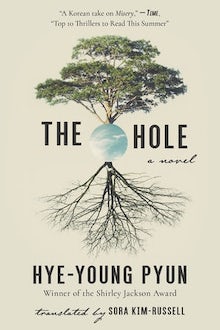 After I read The Hole, I decided to read The Hole, by Hye-Young Pyun, translated from the Korean by Sora Kim-Russell (front cover designation) and published by Arcade. I tried to buy the rights to her second book (City of Ash and Red), but was weeks too late.
After I read The Hole, I decided to read The Hole, by Hye-Young Pyun, translated from the Korean by Sora Kim-Russell (front cover designation) and published by Arcade. I tried to buy the rights to her second book (City of Ash and Red), but was weeks too late.
This is a better Hole! Is it weird? Totally. A man and his wife move out to the country to live in a larger house. They get in a car accident. She dies. He’s physically so fucked—paralyzed, dependent on his mother-in-law, incapable of imagining a normal life. Until the final chapter, the entire book is within the mind of a character confined to bed, having woken up from a terrifying car accident that killed his wife. Like with Johnny Got His Gun/”One,” Oghi can’t move, can’t talk, can’t communicate. He’s beholden to the whims of first his caretaker and her terrifyingly aggressive teenage son, then his mother-in-law. His mother-in-law, who only checks in on him once in a while, while she’s taking breaks from digging a gigantic hold in the front garden.
Aside from the hole digging—which isn’t totally unbelievable—this Hole is much more realistic. Having read her City of Ash and Red, I kept expecting things to get weird, but they really don’t. The horror aspect of this book (which won the Shirley Jackson Award) is much more psychological. Not only is Oghi confined and trapped inside his own head, he’s trapped there with the knowledge of everything that preceded his accident and the death of his wife. (Spoiler: Their marriage wasn’t all wine and roses.)
Although the prose is less dynamic and stylized that Oyamada’s Hole, there’s something compelling in the flat way things are presented throughout, from the opening:
Oghi slowly opened his eyes. The light was blinding. Something flashed at the center of a grayish haze. He closed his eyes, opened them again. The difficulty of this reassured him. This meant he was alive. The physical burden of struggling to open his eyes, of squinting against the light, was proof.
To the moments that feel a bit more sinister:
Oghi and his mother-in-law were alone in the house. It would be that way for a long time to come. His mother-in-law knew a lot of things. She did not hide it from Oghi. For all he knew she might have learned all of the things that his wife thought she knew. The problem was, Oghi had no idea what on earth his wife had known.
Overall, I preferred this Hole to the earlier one. 8.5 out of 10 stars! The plot is a bit too backloaded to get a higher score, but overall, it’s an effectively wild read.
*
Which brings me to the real meat of this post.
I read these two books solely because they were by women and had the same title. There are parallels that any high school student could lock on to—mothers-in-law, moving to a rural area, being confined—and that are fun to bounce off one another, but truly, this read was random. The fact that I liked the second Hole I read more, though . . . that’s interesting to me. It made me wonder—what would a bookseller recommend for me to read next? And why?
I’ve spent years, both here and in my classes, trolling online discovery sites (especially BookLamp, which still holds the crown for dumbest company name in all of books) for the gap between their algorithms and common sense. For example, after reading Sound and the Fury, BookLamp recommends a YA book on growing up in the South. Uh, ok, sure. But no.
This is essentially what indie booksellers are railing against. A human—who knows her clientele and a lot of books—is better at recommending what to read next than a computer is. Is this true? I don’t know! But I’m going to have some fun with it . . .
I sent this same message to a number of my friends—booksellers, readers, translators:
So, I’m going to try and write a post tonight, and as part of it, I want various people to recommend me a book based on two data points: I give The Hole by Oyamada a 6.5/10 and The Hole by Hye-Young Pyun a 8.5/10. What do you recommend I read next?
Synthesizing robot-think with actual responses, here are the various “buckets” of recommendations I received. (And just to be clear, I received recommendations, but I invented all the quotes below.)
The Most Obvious
“What about the other New Directions book called The Hole? The one from Jose Revueltas? Wait, wait, no, maybe Holes by Louis Sachar! A proliferation of holes!”
My Response: STRONG PASS. Title similarity is what got me here, and I’m not sure it’s a path worth following. I don’t have the attention span to read, compare and contrast, interrogate the idea of “holes” in fiction right now. And I definitely don’t want to read YA about Latvian great-great-grandfathers named Elya Yelnats.
Also Super Duper Obvious
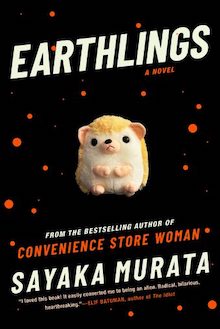 “Earthlings by Sayaka Murata! Also Japanese, also a woman, also weird! And brand new, so we have six copies to sell. Did you read Convenience Store Woman? It was sooooo quirky. Perfect for anyone who liked The Hole!”
“Earthlings by Sayaka Murata! Also Japanese, also a woman, also weird! And brand new, so we have six copies to sell. Did you read Convenience Store Woman? It was sooooo quirky. Perfect for anyone who liked The Hole!”
My Response: Dude, seriously? Convenience Store Woman is way too twee—the exact thing I disliked about The Hole. The first Hole. Oyamada’s Hole. Whatever. Is that a Star Wars porg on the cover? Gross, no, fuck that, pass. Stop texting me, thankyouverymuch.
“The Vegetarian is also a work of body horror like Pyun’s The Hole. If you haven’t read that, I’d recommend going there next.”
My Response: Read it! And rejected it when it was on submission! Thanks for reminding me that I’m bad at my job. But seriously, isn’t it too obvious to try and group authors by their country of origin? Just because Pyun is Korean doesn’t mean the next the book I read should also be Korean. The Republic of Letters is global, yo. Translation exists to erase boundaries. To allow us to compare a Korean book to a Brazilian one to a Canadian one. Free your mind!
The Slight Swerve
“I’m going to go with Siamese by Stig Sæterbakken. Also weird, disturbing, and we have a copy in stock.”
My Response: Intriguing! A book I helped sign on at Dalkey Archive more than a decade ago, so you’re totally right that I would enjoy it. And I can see the parallels between Oghi trapped in his bed and Edwin Mortens (from Siamese) stuck in the shitter. This is good stuff, although I always flinch when I mention two female writers and I’m recommended a male. Probably shouldn’t be a thing, but in 2020, it kind of is.
“Pew by Catherine Lacey.”
My Response: OK, here we fucking go! A relatively new book, but not the current Buzz Book. It was nominated for some award or other, and Lacey was at the Ledig House a few years ago, which is strangely signal boosting for me, so OK. Putting it on the pile!
Still Obvious: The Bestseller Version
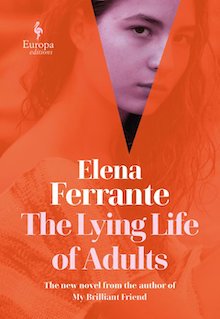 “Maybe The Lying Life of Adults by Elena Ferrante. Lives up to the hype, is bringing an indie press a ton of money, and will provide you with ample opportunities to talk to other readers, since it is a best-seller and Ferrante has a billion friends.”
“Maybe The Lying Life of Adults by Elena Ferrante. Lives up to the hype, is bringing an indie press a ton of money, and will provide you with ample opportunities to talk to other readers, since it is a best-seller and Ferrante has a billion friends.”
My Response: This is interesting. I complain all 2020 long about being lonely—you try living in Rochester—and we all know I love moms, but this just doesn’t seem like a logical reading path. There’s something to be said for a swerve—read too much of the same thing in a row and you’ll experience the reading reality of diminishing returns—but reading is still mostly solitary and, to be honest, I have yet to see a truly interesting discussion of this Ferrante online. I’m certain it’s a good book, but I don’t know that this is what I need right now.
“Have you read the new DeLillo? What a pile of shit.”
My Response: I actually bought a copy because my daughter and I are going to read Underworld together this winter and I thought, “why the fuck not?” Then, when it arrived in the mail, I opened it up. There are approximately 100 words on every one of its 117 pages. This book is totally geriatric in its production. Not to mention, this is the opening paragraph:
The man touched the button and his seat moved from its upright position. He found himself staring up at the nearest of the small screens located just below the overhead bin, words and numbers changing with the progress of the flight. Altitude, air temperature, speed, time of arrival. He wanted to sleep but kept on looking.
Sure, OK. Plane time is a weird time. But if you want that, go check out In Transit by Brigid Brophy. I would love if every bookseller in America recommended her experimental classic instead of the new DeLillo. Also, I don’t need tenure to tell you that Zero K sucked ass.
If I Were a Library
“I’ve thought about your question, and I think you should read Memories of Underdevelopment by Edmundo Desnoes.”
My Response: I want to engage with this one! The problem with bookseller recommendations is that, if they’re maximizing efficiency and profit, they’ll recommend books they have on hand. And the more copies you have, the more you want to sell that book. This is the total opposite. I’ve never ever heard of this book—nor the movie made of it. Why did this come to mind in relation to The Holes? No idea! Totally intrigued, but . . . .
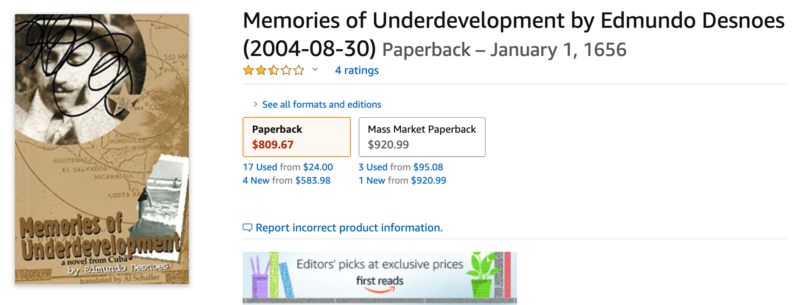
I’m a publisher! $809.67 (why not $809.69, you know I had to that joke is right there) is like twenty times my monthly salary. Also, how the fuck did this get published in 1656? I’m starting to believe that some of the information on Amazon.com isn’t 100% true.
Staying in the Ballpark
“What about Count Luna or The White Dress? Both very different but great in their own ways.”
My Response: I want to like Nathalie Leger more than I actually do. I’ve read the first two books from the trilogy and wish her/Dorothy/her translators the best, but I think I want something else right now. But this is a solid recommendation! Both of these came out recently, so it’s unlikely—if I were a normal customer and not one who enters every translation he finds into an ever-growing database—I would have heard of these. Solid recs.
Asking the Customer
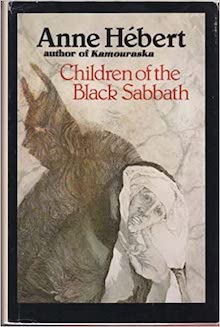 “What are you looking for? More books from that part of the world? Something weird? What about Mercè Rodoreda? Or Children of the Black Sabbath. No, it’s not about the band. It’s a Queb book that isn’t in print. Yeah, you’re right, that’s a problem.”
“What are you looking for? More books from that part of the world? Something weird? What about Mercè Rodoreda? Or Children of the Black Sabbath. No, it’s not about the band. It’s a Queb book that isn’t in print. Yeah, you’re right, that’s a problem.”
My Response: I think creating this feedback loop is key. Algorithms take X + C and make it = V. If you gave four stars to The Boys you’ll love Powers. (Which, well, for all of you Boys fans? This is my recommendation. Make of it what you will or won’t.) This harkens back to the earlier comment that I might not want three of the same thing in a row. Readers need a bit of variety, and something surprising can be a welcome relief. I’m not sure algorithms will ever be able to incorporate serendipity. (They’re probably totally capable of this but I’m too scared to read all the books I buy about this subject because Instagram won’t stop sending me ads about weight loss and non-alcoholic beverages.)
What’s Hip? THIS.
“WAIT. Aren’t we all reading Gaddis’s J R right now? I’ve heard it’s the Greatest Book of the Twentieth Century. And it’s a rediscovered classic!”
My Response: HOW THICK IS YOUR SKIN, NICK DURING? First off, J R is a mother-fucking masterpiece. That, well, sorry to burst all y’all’s bubble, has never been out of print. It’s moved from Penguin to Dalkey to NYRB, but it’s always been there, waiting for the hipsters to hip. (And they have! Time and time again. The first question I was asked at Dalkey in 2000 when I started was: “Which do you prefer, The Recognitions or J R?”) We’re doing a TMR season on this because I want to feel loved and seen again. There’s literally no need to recommend me things that are already trendy. Trendy beloved books are like the buzzkill of reading to me. And seriously, if this is your discovery? UGH. Sorry, bro, but I’m not going out of my way to support your bookstore. You are The Average.
Did You Choose a Book?
No one guessed what I decided to read next, and next to no one—Pew and Memories of Underdevelopment aside—ended up having that much of an impact. I’m reading The Third Reich by Roberto Bolaño. Reading habits are unpredictable. We are all tools pushing our shit onto others, but, really, all you can do is offer a great selection, highlight the cool, the weird, and hope for the best. So far? I’m not sure this worked! I feel like the average person is a dumber reader today than in 1998 when I first worked at Schuler Books & Music. But, well, I’ll develop that argument later. I doubt four of you even read that sentence.

Leave a Reply